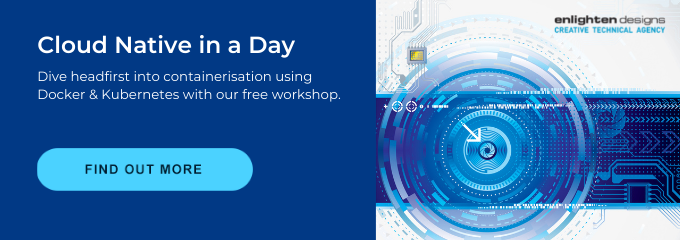What Is Software Containerisation?
To understand how Microsoft Kubernetes works, we’ll first explore the subject of software containerisation.
‘Software containerisation’ means that a software application has a standard exterior. With a standard exterior, the application can run on any machine regardless of the operating system.
Software containerisation allows an application to run on any operating system.
In a recent interview, Jordan McFarlane - Team Lead, web and CMS practice at Enlighten Designs - compared software containerisation to a cargo container. For years, there were no cargo containers; warehouse workers had to load everything by hand, and it was a laborious, challenging process.
In 1956, American trucking company owner Malcolm McLean patented the first standard shipping container. This standardised shipping container enabled transportation companies to load cargo onto vehicles efficiently. Software containerisation is a bit like shipping containers: it standardises software applications, so running them becomes more efficient for IT departments.
Managing Software Containerisation
Let’s say you’ve got a number of software containers, and they’re running on several servers. Managing one or two containers isn’t challenging. It's when you have more containers, and more places you're running them on, where the challenge of greater complexity comes into play.
You have to schedule those containers to run applications and you need to run periodic checks on their health to see if they’re functioning properly. Moreover, you may need to scale an application in a software container so more people can use it. That’s where Microsoft Kubernetes comes to the rescue.
What Is Microsoft Azure Kubernetes?
Microsoft Azure Kubernetes is open-source software for deploying and managing software containers at scale. The name of the solution comes from the Greek word for a ship helmsman or pilot. Azure Kubernetes allows you to steer your container strategy towards smooth seas.
How Does Azure Kubernetes Work?
Kubernetes cuts through the complexity of managing multiple containers that run in more than one location. It does that by providing an API to control how and where those containers will run.
Also, Kubernetes orchestrates virtual machines clusters, meaning it controls them by scheduling those clusters to run based on a virtual machine’s available compute resources and each container’s resource requirements. Kubernetes groups containers into pods, which can scale up to match usage requirements.
Kubernetes cuts through the complexity of managing multiple containers running in more than one location.
In addition, Kubernetes does the following things:
- Automatically manages services discovery
- Incorporates load balancing
- Tracks resource allocation
- Scales based on compute utilisation
- Checks the health of individual resources
- Enables apps to self-heal by automatically restarting or replicating containers.

The Benefits of Azure Kubernetes
There are several benefits of using Kubernetes in your organisation:
- Portable workloads
- Containers scale easily
- Workflow automation
Portable Workloads
When you run an application on Kubernetes, the app becomes portable. That means it’s separate from its infrastructure so that you can run it anywhere.
If you want to run an application in the cloud, you can do it with Kubernetes. Running it on-premises isn’t an issue, either. Moreover, it’s simple to move the application from location to location. The container ensures that the app will always run as intended.
Containers Scale Easily
Let’s say you have an application that can accommodate up to 200 users at once. However, you’ve hired another 50 people, and those employees need to use that application.
Kubernetes scales up quickly and easily. You can configure Kubernetes to scale up automatically in response to greater loads placed upon the application. Again, thanks to containerisation, the app runs consistently regardless of the load placed upon it.
Workflow Automation
Kubernetes also enables workflow automation. As we mentioned earlier, it can automatically scale. Users can also configure the solution to check the health of applications and self-heal apps.
These capabilities save the IT department time and money. The IT team doesn’t have to allocate new resources, so a given application can scale manually. Additionally, they don’t have to check for apps that aren’t functioning properly because Kubernetes monitors application health.
Azure Kubernetes Services: A Managed Kubernetes Solution
Kubernetes can become even easier when you use Azure Kubernetes Services (AKS), Azure’s managed Kubernetes offering. AKS offers serverless Kubernetes, an integrated continuous integration and a constant delivery experience. In addition, there’s the same enterprise-grade security and governance Microsoft builds into all its products.
With AKS, you receive:
- Elastic provisioning
- Faster end-to-end development
- Comprehensive authentication and authorisation
- Wide availability.
Elastic Provisioning
With elastic provisioning, AKS provisions capacity without you needing to manage infrastructure. You can also add event-driven auto-scaling and triggers, so AKS will provision the capacity you require without manual intervention.
Faster End-to-End Development
Because Kubernetes is part of the Microsoft Azure suite, you can access Visual Studio Code Kubernetes tools, Azure DevOps, and Azure Monitor.
These tools speed up development so that you save time, effort, and money. Your IT team can focus on more valuable activities that drive the organisation forward.
Comprehensive Authentication and Authorisation
With tools available through Azure, you have the peace of mind that Kubernetes can run securely.
AKS uses Azure Active Directory for comprehensive authentication and authorisation capabilities. Also, Azure Policy dynamically enforces security rules across Kubernetes clusters to keep them safe from threats.
Wide Availability
Customers from around the world appreciate Microsoft Azure’s widely available cloud infrastructure. Because Kubernetes is part of the Microsoft Azure family, it’s available to many customers, regardless of their geographic location.
Enlighten Designs: Simplifying App Containerisation with Kubernetes
For over two decades, Enlighten Designs has delivered amazing digital experiences to its clients. We’re a proud Microsoft partner. Moreover, we understand how to deploy Kubernetes to boost your IT team’s productivity and efficiency. To learn more about Kubernetes, sign up for our free Cloud Native in a Day Workshop.

